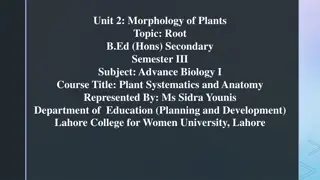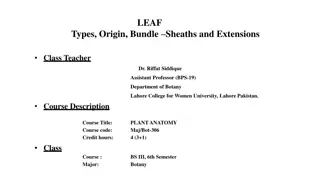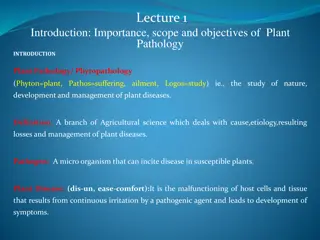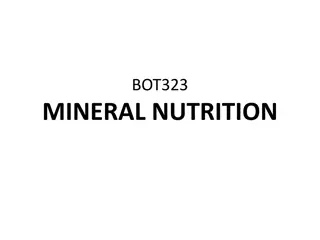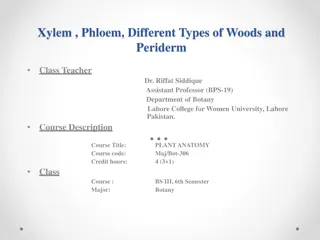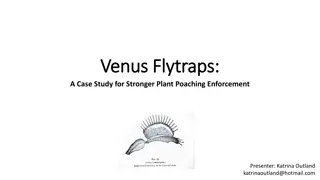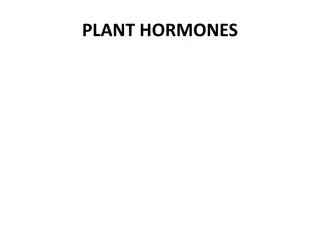Economic Aspects of Applied Plant Anatomy in Practical Use
Applied Plant Anatomy involves the practical application of anatomical knowledge in various fields such as identification, classification, taxonomic applications, medicinal plants, food safety, wood analysis, forensic investigations, and more. By understanding plant anatomy, professionals can utilize this knowledge for a range of purposes, from diagnosing diseases in plants to discovering new species based on anatomical features. Economic aspects play a crucial role in utilizing plant anatomy effectively for different applications, contributing to advancements in agriculture, medicine, and various industries.
Download Presentation

Please find below an Image/Link to download the presentation.
The content on the website is provided AS IS for your information and personal use only. It may not be sold, licensed, or shared on other websites without obtaining consent from the author.If you encounter any issues during the download, it is possible that the publisher has removed the file from their server.
You are allowed to download the files provided on this website for personal or commercial use, subject to the condition that they are used lawfully. All files are the property of their respective owners.
The content on the website is provided AS IS for your information and personal use only. It may not be sold, licensed, or shared on other websites without obtaining consent from the author.
E N D
Presentation Transcript
ECONOMIC ASPECTS OF APPLIED ANATOMY By Dr. Shabnum Shaheen
ANATOMY Definition Study of internal structure of various parts of the plant. PLANT BODY: Organs (root, stem, leaves) Tissues (ground tissues, vascular tissues, dermal tissues) Cells (ground, vascular and dermal tissue cells)
APPLIED ANATOMY The practical application of anatomical knowledge to diagnosis and treatment. Also known as clinical anatomy.
ECONOMIC ASPECTS OF APPLIED PLANT ANATOMY Identification and classification Taxonomic application Medicinal plants Food adulterants and contaminants Animal feeding habit Wood present day Wood in archaeology Forensic applications Paleobotany Applied aspects of meristem culture
1. IDENTIFICATION AND CLASSIFICATION Cytologists, geneticists, ecologists, plant breeders, chemists and anyone using plants for medicine, food, furniture, fabric or building material, or those conducting molecular research on plants, must be able to identify their source material through anatomy. Natural, accurate and reliable classification result from taking into account features of anatomy, morphology, palynology etc. Better and easier identification and classification.
2. TAXONOMIC APPLICATIONS Anatomical data is useful in discerning evolutionary trend and relation between taxonomic categories. Example 1: genera Anarthria and Ecdeiocolea were formerly treated as members of the Restionaceae. An extensive anatomical survey of the family Restionaceae showed the two genera to be misfits. Example 2: Tree leaf material in China was examined anatomically Plant was Pycnarrhena macrocarpa. Further study of species from this genus led to discovery of new genus Eleutharrhena
Group of stomata in abaxial surface of Eleutharrhena macrocarpa (a). In (b), Pycnarrhena pleniflora, the stomata are scattered over the abaxial leaf surface.
3. MEDICINAL PLANTS Drugs are extracted from leaves, barks, roots or rhizomes of plants. It is quicker to find out the identity of crude drugs from its anatomy than its chemistry. Pure material and adulterants are differentiated by anatomical confirmation. Example: Ipecacuanha, used in cough mixture can be adulterated with roots from alternative inferior species. The authentic source of the drug is Cephaelis ipecacuanha (Rubiaceae).
Example: Ipecacuanha, used in cough mixture can be adulterated with roots from alternative inferior species. The authentic source of the drug is Cephaelis ipecacuanha (Rubiaceae). Sometimes Cephaelis acuminata is used as a substitute.
Examples: Occasionally substitute may be poor or unsuitable. Rheum officinaleroot and rhizome is used medicinally. But Rheum rhaponticum is the vegetable. Fortunately, chemical and anatomical tests can be applied to detect which species is present. Digitalis purpurea and D. lanata are used medicinally. They can be distinguished from one another on anatomical grounds
4. FOOD ADULTERANT AND CONTAMINANT Some herbs are used extensively in seasoning. These are often imported in the form of dried powdered plant parts. It would be easy to introduce useless or sometimes even poisonous adulterants which would be difficult to detect with the naked eye. Ailanthus leaf has also been used as a mint adulterant.
Food contaminant Foreign bodies sometimes get into food by accident. Often these are small and fragmentary and can be identified only with the microscope. Example: A splinter of wood in butter was found to come from a species of Pinus. The importer and packers hoped to be able to determine if the splinter could have come from the country of origin of the butter, or whether it might have been introduced during the packing stages.
5.ANIMAL FEEDING HABITS Animal sometimes consume crop plants. It is possible to find out what has been eaten by studying the composition of faeces, or stomach. For example faeces from rabbits, foxes etc. Fragments of plant are very small when they have passed through an animal s digestive system. Fragments are put into a petri dish, and the sample divided into its components. These fragments from each dish are examined using under the light microscope. Some African cattle were being injured by eating grasses. The cattle only ate the grass when other plants were unavailable. Faeces were examined and reported that there were silica bodies and sharp hairs present. Domestic animals occasionally eat poisonous The owner of the animals can then take precautionary measures against further livestock poisoning.
6.WOOD: Present Day samples sent to Kew for anatomical identification consist mainly of wood. The samples derived from different sources. The British Standards Institute has published a list of common names and the species from which the woods come, and this is the authoritative work which has to be followed. Preservation of wood is considerable economic importance. experimental anatomy carried out in various parts of the world in order to establish prevention of their degrading activities.
7.WOOD: In Archaeology These characters also enable to identify the wood and charcoal preserved in sites from antiquity. Features like perforation plate and lateral wall pitting are still retained. The wood of archaeological sample is compared with that of present-day-wood India produce evidenceuse of wood. The Indus Bronze Age civilization of Harappa and the Copper Age civilization of Hastinapura, were aware by uses of wood. Deodara for making coffins has property of shock absorbing and Harappans were aware of these fact. Dalbergia sissoo and Holarrhena antidy senterica these two timber-yielding plants. These plants provide fuel woods. Corylus were well preserved in waterlogged condition in Somerset at Bronze Age. Apart from wood and charcoal other archaeological plant remains are also preserved. For example a sandal was preserved in ancient Egypt.
8.FORENSIC APPLICATIONS The application of forensic science is helpful in investigating a crime. Use of plant materials in solving crimes or other legal problems. The morphological and anatomical diversity expressed by plant species provide characters to identify plant parts. Plants remains are present every where in form of macroscopic pieces and microscopic forms. Edible plants are used to identify the stomach contents and last meal of a victim. In dicotyledonous roots growth rings can indicate the number of years passed since burial. Dendrochronology techniques enable to date the wood and so the year of painting. These techniques are also used to detect when the wood was used to make art objects or musical instruments etc.
FORENSIC APPLICATIONS EXAMPLE: In 1932, in the evening of March 1st the infant son of famous American aviation hero Charles Lindbergh was kidnapped from his home in Hopewell, New Jersey, US. dead body of the son was discovered a few miles away from the family home. The ladders were the only evidence left at the scene. They were homemade and crude. Xylotomist Arthur Koehler of United state Forest Services in Wisconsin examined the wood of the ladder both morphologically and anatomically. four species were used to construct the ladder namely Yellow pine, Pinus, ponderosa, Douglas fir and Betula sp. The basis of identification was the microscopic analysis of grain patterns of the woods.
9.PALEOBOTANY - Helps in identification of fossils - Placed in extant families and genera - Determines if roots or stem - Fossils may be sectioned, grounded
10.APPLIED ASPECTS OF MERISTEM CULTURE Apical Meristem At tips of root, shoot and leaf The shoot is used in culture by cutting it out and placing in nutrient medium (composition and conditions) Micropropagation Usage in horticulture, forestry, agriculture Conservation of endangered species (orchids) Example: Manihot esculentus
Intercalary Meristem Meristem at internodes Adventitious roots formed at nodes Horticulture use propagation of plants by stem cuttings Example: Dianthus
Lateral meristem On lateral sides, consisting of vascular and cork cambium Example: Cork cambium and fascicular cambium Wound can regenerate Employed in plant propagation by cutting and grafting
Students and Government Benefits Classification in classifying correct families and orders Identification in giving correct names Paleobotany fossils classification For taxonomists Meristem culture in propagation and removing diseased plants Quality of furniture improved by identifying wood Identification of medicinal plants Improving food quality



